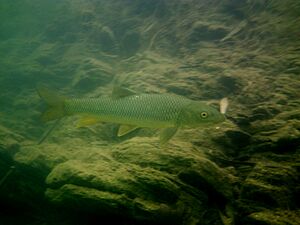Andalusian barbel facts for kids
Quick facts for kids Andalusian barbel |
|
|---|---|
 |
|
| Conservation status | |
| Scientific classification | |
| Synonyms | |
|
The Andalusian barbel (scientific name: Luciobarbus sclateri) is a type of freshwater fish. It's also known as the gypsy barbel. This fish belongs to the Cyprinidae family, which includes carps and minnows.
About the Andalusian Barbel
The Andalusian barbel is a special fish found only in a specific part of the world. This means it is endemic to the southern Iberian Peninsula. This area includes parts of both Portugal and Spain.
Where It Lives
This fish likes to live in the middle and lower parts of rivers. You can find it in river systems from the Segura River to the Mira River. It is not very picky about its home. It will live almost anywhere except small, cold mountain streams.
Life Cycle
Andalusian barbels lay their eggs, a process called spawning, at the start of summer. This usually happens between May and June. Male fish become ready to reproduce when they are 2 to 4 years old. They are about 8 centimeters (3 inches) long then. Females take longer to mature. They are ready to reproduce in their sixth or seventh year. At that time, they are usually 11 to 16 centimeters (4 to 6 inches) long.
These fish can grow to be quite large. They can reach a maximum length of about 50 centimeters (20 inches). They also live a long time. Some Andalusian barbels have been known to live for up to 18 years!
Is It in Danger?
The Andalusian barbel is quite common. It is not considered a threatened species by the IUCN. However, some local groups of these fish can disappear. This often happens during summer droughts. Droughts can dry up the small creeks where they live. This also causes their habitats to break apart. This makes it harder for them to move around and find new places to live.


